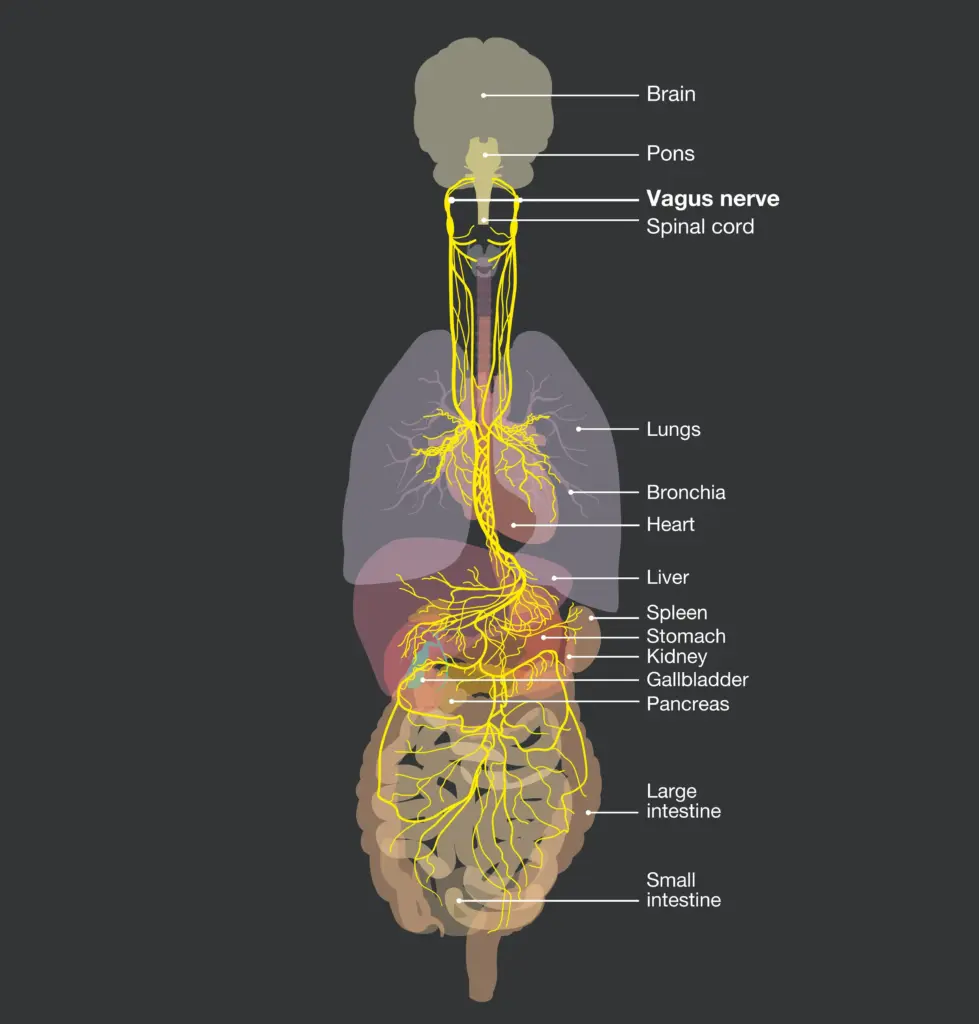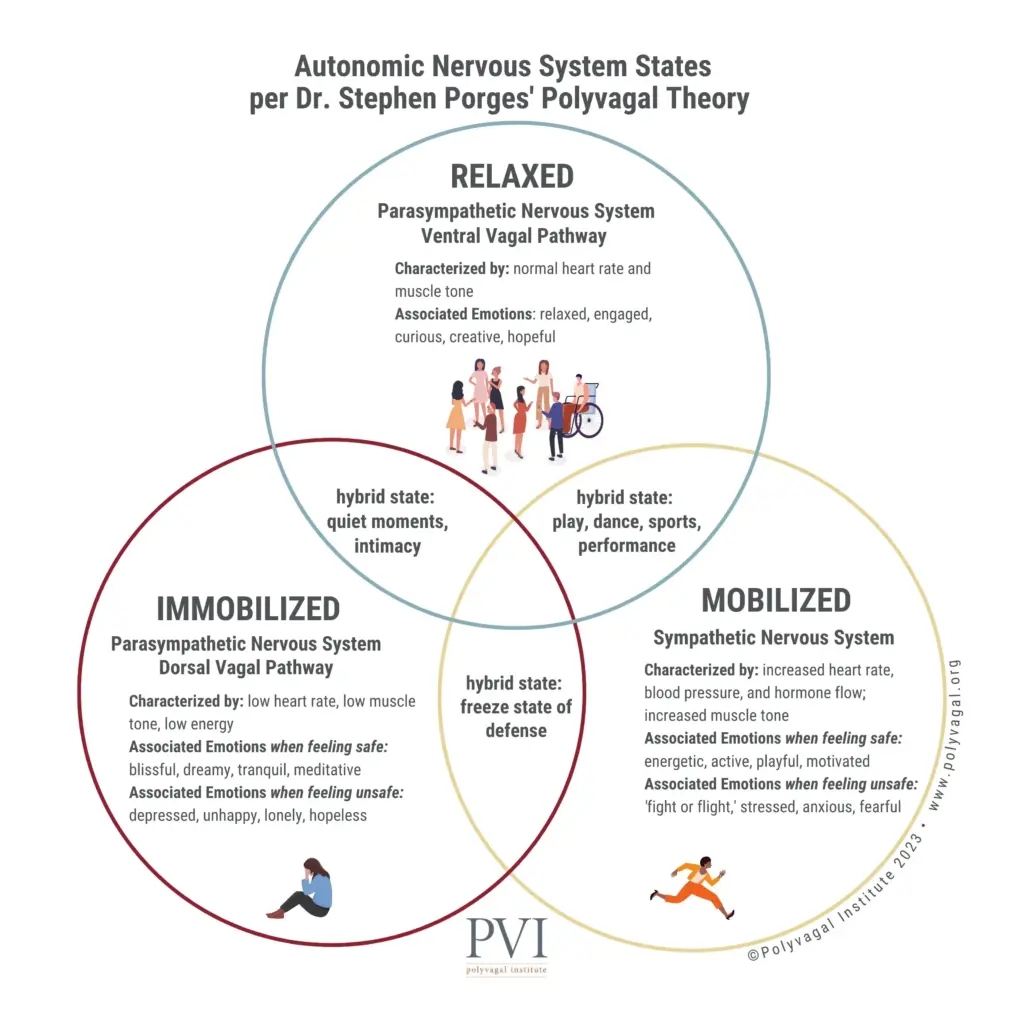Inhaltsverzeichnis
- How specific music therapy regulates your nervous system
- What is the autonomic nervous system – and why is balance so important?
- Polyvagal theory: the basis for the Safe and Sound Protocol
- Music as medicine for the nervous system: The Safe and Sound Protocol (SSP)
- Music meets the nervous system – how the SSP works: Neurobiological background
- Who benefits most from SSP?
- The process of a guided SSP programme – step by step
- Experience: What do clients report from practice?
- SSP and everyday life: Achieving lasting balance in the nervous system
- Limitations and important information about SSP
- Conclusion: SSP as an innovative building block for self-regulation and healing
How specific music therapy regulates your nervous system
The way our society is structured, we are essentially living in a state of war. I don’t even mean the wars we wage against each other (bullying, exclusion, etc.) or necessarily the wars around the world. I mean the wars waged with biological weapons, AI and an endless flood of information. What is true? What is false? Who can we trust? We are in an information war. An AI war. A resource war.
As great as the rapid digital changes are, we as humans – and especially children! – are completely overwhelmed. Our autonomic nervous system is not designed for information overload (of any kind).
We automatically switch into survival mode. Unnoticed.
Added to this are the daily survival modes: constant availability, high workloads, pressure to make decisions and, as a result, emotional overload, which we only notice when stress symptoms set in. While some people achieve a lot, they do not realise that, despite appearing to “function” on the outside, they are increasingly slipping into survival mode and losing their genuine vitality.
This makes our ability to self-regulate all the more important: in other words, to repeatedly restore our own balance between tension and relaxation, productivity and recovery, between alertness and a feeling of security.
Very few people have learned self-regulation. This may be because their parents and grandparents were not regulated themselves and ‘faster, further, higher’ was the maxim.
This alone is already a major challenge, because being constantly ‘ON’ and hustling has become our ‘normal’. Classic methods such as sport, meditation and therapeutic offerings are well known (and yet often misunderstood) – but innovative tools for nervous system regulation, such as the Safe and Sound Protocol (SSP), are becoming increasingly important when it comes to health and healing at the physical and cellular level.
The SSP combines the latest neuroscientific findings with the ancient medium of music. It acts directly on the autonomic nervous system via our relaxation nerve (vagus nerve) and helps to sustainably reduce stress reactions, anxiety and overload. What does the SSP do and how can it revolutionise the regulation of your nervous system – especially when you are or have been in high-performance mode without really noticing it?
Our vagus nerve runs through the entire body, including the face.

What is the autonomic nervous system – and why is balance so important?
To understand the effect of the SSP, I look at the foundation: our autonomic nervous system (ANS). Our control centre works unconsciously – it regulates our heartbeat, breathing, digestion, immune system and our ‘internal alarm system’. It essentially consists of three areas:
- Sympathetic nervous system (activation, fight-or-flight response)
- Parasympathetic nervous system (rest, digestion, repair)
- Vagus nerve (connecting link, particularly important for social calm and regeneration)
When our nervous system is balanced, we experience a natural alternation between tension and relaxation. We can respond flexibly to challenges, feel secure, socially open and capable of acting.
However, if the system is dysregulated, diffuse symptoms arise that we often consider ‘normal’: fatigue, irritability, concentration problems, sleep disorders, tension or recurring infections.
Why does this particularly affect high performers?
People with a high level of motivation, perfectionism or self-discipline often remain in ‘survival mode’ for a long time before their body and mind sound the alarm.
The autonomic nervous system remains in a state of constant stress – often unnoticed – and standard relaxation methods no longer work properly.
Polyvagal theory: the basis for the Safe and Sound Protocol
The polyvagal theory was developed by Dr Stephen Porges and is now the basis for many modern trauma-sensitive therapy methods.
The polyvagal theory explains how our nervous system reacts to stress or relaxation. Our body reacts automatically to situations – for example, with fight, flight or freeze responses. Depending on how safe or unsafe we feel, our nervous system switches to different ‘programmes’. This usually happens unconsciously and influences how we feel and how we act.
The core idea according to Dr. Steven Porges is therefore:
Our vagus nerve (relaxation nerve) forms a complex network with other nerve pathways that constantly regulates our well-being, safety and social behaviour.
According to this theory, there are three main states of our nervous system:
- Social contact (ventral vagus): Here we feel safe, open, connected, creative and compassionate.
- Fight/flight (sympathetic nervous system): When we perceive danger, our system switches to action mode – we become alert, irritable, anxious and driven.
- Freeze (dorsal vagus): When we are overwhelmed, our body and mind switch to emergency mode – we feel cut off, paralysed, numb or depressed.
According to this model, targeted stimuli, such as the stimulation of certain frequencies through music, can help our nervous system return to a state of safety and regulation. We then experience feelings of stress dissipating and a sense of ‘arrival’ and social openness returning.
The Safe and Sound Protocol specifically draws on this approach and harnesses the strengthening power of music for the health of body and soul.

Music as medicine for the nervous system: The Safe and Sound Protocol (SSP)
The Safe and Sound Protocol (SSP) is a special music-based listening intervention developed by Dr. Stephen Porges. The aim of the SSP is to specifically stimulate and gradually strengthen the ventral vagus – the social, safety-promoting element of our nervous system.
The SSP consists of a series of pieces of music (five one-hour modules) that are filtered using a special algorithm to highlight the frequency ranges that are crucial for social security. The sounds are similar in their gentle, connecting effect to friendly human voices – the nervous system thus “learns” to recognise signals of security and calm and to respond to them.
Why does music work?
Music – and especially the human voice – is one of the most powerful ways to influence our nervous system. It appeals to the most ancient part of our brain:
- Sounds, especially at certain frequencies, signal to the body that ‘everything is okay’.
- They help us regain feelings of security, connection and well-being in stressful times.
Singing mantras in the yoga tradition has a very similar healing effect: the steady, soothing sounds create a feeling of connectedness and inner peace. In my own yoga school, I have repeatedly experienced how mantra singing in particular can open up a deep connection to oneself for my yoga students.
Music is therefore a key to recovery and to regaining access to regulation and a healthy balance on a subconscious level.
The sounds of the Safe and Sound Protocol resemble friendly human voices in their gentle, connecting effect – our nervous system ‘learns’ to recognise signals of security and calm and to respond to them.
Christine Rudolph, psychotherapist (HPG) and polyvagal therapist
Music meets the nervous system – how the SSP works: Neurobiological background
The SSP works with specially filtered music. The aim is to stimulate the nervous system in the same way as the empathetic voice of a familiar person or the soothing sounds of a safe environment. Technically, these are processed music files whose frequency ranges are specifically tailored to social perception.
The basic assumption:
When the nervous system is regularly and gradually exposed to these safe sounds, it learns to relax again in a state of safety instead of remaining in a state of alertness or inner paralysis. The system ‘switches’ from (unconscious) danger to ‘safety’.
What does science say?
Numerous studies have now proven the effectiveness of SSP. Positive effects have been demonstrated in particular for:
- chronic stress
- anxiety disorders
- Depression
- Trauma consequences (PTSD, attachment and developmental trauma)
- Autism spectrum disorders
- ADHD and concentration problems
This study, for example, investigated the effect on children with autism and showed significant improvements in communication readiness and social behaviour, as well as a reduction in anxiety, hyperarousal and hypoarousal.
You can find a current overview of scientific publications here at PubMed – search for ‘safe and sound protocol’.
Heart rate variability (HRV) and other markers
Further research and studies have shown improvements in heart rate variability, an important physiological marker for nervous system balance. Many participants report the following in their everyday lives:
- Relief from chronic irritability or anxiety
- More energy and clarity
- Better sleep patterns
- Faster emotional recovery after stress

Who benefits most from SSP?
SSP is suitable for people who feel that ‘it’s too much’ – in other words, whenever the autonomic nervous system is no longer able to flexibly regulate stress, trauma or chronic overload.
- People with stress-related disorders (e.g. burnout, exhaustion depression)
- Those who have undergone therapy for chronic symptoms that no longer respond properly to conventional methods
- Highly sensitive and high performers who frequently suffer from ‘invisible pressure’
- People who have experienced trauma (attachment trauma, developmental trauma, consequences of accidents)
- Children and adults with ADHD, autism or social anxiety
- Clients in coaching, supervision and systemic counselling
Reports from practice show that even people without classic diagnoses – such as increased irritability, persistent exhaustion or unexplained physical complaints – can benefit greatly.
Testimonial from a client:
‘I didn’t realise how much I was living in a constant state of alert. After the SSP, I experienced moments of genuine peace and joy for the first time in years. I sleep better, I’m clearer and more creative!’
You can find more second opinions and user reports in this article: SSP experiences from practice.
The process of a guided SSP programme – step by step
I work with the Safe and Sound Protocol in therapy and coaching, simply in many cases with people who have had traumatic experiences. I also combine it with EMDR, which is very effective.
Preparation phase: safety and setting
Before starting, the setting is customised. Safety, support and follow-up discussions are essential, especially in cases of trauma:
- Medical history/preliminary discussion: clarify symptoms, expectations, contraindications
- Explain the procedure, both technically and emotionally
- Choose a suitable environment (at home, in the practice, online)
Implementation: music, breaks & support
The actual SSP consists of five music modules (around five hours in total), divided into 20–30-minute sessions over several days or weeks. The pace is adjusted individually – sometimes five minutes per session is enough, or even less if you experience sensory overload.
While listening, you can relax, paint, do puzzles or engage in quiet activities. However, there should be no distractions (e.g. mobile phone or TV). You listen to the music with high-quality, wired headphones, preferably without interruptions.
As your therapist and coach, I will of course support you during and between our sessions in dealing with any feelings or memories that arise.
Integration: debriefing and stabilisation
After each session, you reflect on how you are feeling mentally and physically. At the end of the SSP, we discuss the development of your individual follow-up strategy in a final consultation:
- How do you perceive changes?
- What are you proud of?
- What will help you with dysregulation in the future?
Tip: An integration diary can help you notice subtle changes!
Online SSP versus in-person SSP
Thanks to digitalisation, the SSP is now available as an online service. Many of my clients use it at home, with accompanying video support or regular check-ins with me.
Advantages: Familiar environment, flexible time management.
Disadvantages: For people who are under a lot of stress, personal support while listening is still recommended in order to cushion intense emotional processes.
Experience: What do clients report from practice?
With over 100 clients I have accompanied, I have found that SSP often triggers very subtle, but sometimes also astonishingly rapid changes. The reactions range from a ‘gentle return’ to a marked reduction in paralysing feelings of stress.
Some voices from my practice (anonymised):
Miriam, 54, CEO: ‘I can’t remember the last time I needed Lorazepam. Since I’ve been using the SSP, I don’t need it anymore.’
Tom, 41, entrepreneur: ‘After a few weeks with the music, I notice that I’m less reactive to emails and phone calls, I feel more like myself again.’
Sabine, 12, ADHD: ‘Mum says I sleep more peacefully now. I can concentrate longer at school.’
Typical changes:
- Improved sleep
- Faster recovery from stress
- Reduced anxiety, especially in social situations
- Less exhaustion, more joie de vivre and courage
- More relaxation in relationships (partnership, work, family)
SSP is not a ‘panacea,’ but rather a catalyst for inner change. It is not uncommon for further methods to be needed after completion to deepen and stabilise the effects.

SSP and everyday life: Achieving lasting balance in the nervous system
SSP can act as a ‘reset’ for the nervous system – but how can this effect be maintained in everyday life?
Integration into everyday life
- Your own polyvagal playlist: After SSP, it helps to put together a playlist of calm, gentle songs with pleasant voices/frequencies. This music can be used whenever you feel overwhelmed or stressed.
- Develop rituals: Incorporate short music sessions into your morning or evening routines. Allow yourself breaks during which you consciously listen to music and focus on how your body feels.
- Combine with breathing or mindfulness exercises: Some participants use short breathing breaks or extend the effect with simple yoga or embodiment flows.
- Strengthen social connections: Consciously seek out contacts with whom you feel safe. This allows the nervous system to remain in ‘safety mode’.
Example of a personal music routine
Morning:
After getting up, listen to calming music for 5–10 minutes, breathing consciously and possibly doing a few gentle movements.
Evening:
Quiet music as a ‘wind-down module’ – ideal before bedtime.
This keeps the nervous system in a regulated state and maintains the effect of SSP.
Limitations and important information about SSP
Despite its success, SSP is not suitable for everyone and should always be considered on an individual basis.
For whom is SSP not (yet) suitable?
- Acute psychotic disorders
- Epilepsy (only after consultation with a neurologist)
- Unprocessed severe trauma without viable therapeutic support
- Severe sensory hypersensitivity (very slow approach may be necessary)
Why professional support is essential
Especially in cases of severe or long-standing trauma, SSP can trigger intense feelings, memories or physical sensations. Therapeutically experienced support is essential here – also to keep the process safe and to intervene in a stabilising manner if necessary.
What SSP is not
SSP is not a universal healing method, but an innovative addition to the overall process of self-regulation. It does not replace trauma-specific psychotherapy for severe conditions. If you are unsure, please feel free to contact me.
Conclusion: SSP as an innovative building block for self-regulation and healing
The Safe and Sound Protocol combines modern neuroscience with the wisdom of music. It gently creates access to inner security, joy of life and inner balance. Especially for people who – often unconsciously – lose themselves in functional mode, SSP can become a ‘door opener’ for real transformation.
Our nervous system plays a central role in our health and well-being. I see time and time again how much can change when people start working with their nervous system. Imbalances in the nervous system can have a very negative effect on our well-being and health. Approaches such as SSP help to regulate the nervous system in the long term.
Whether you are a high performer, an adult with trauma experience or in a family context, I would be delighted to support you.
(Please note: This article is not a substitute for medical or therapeutic advice. If you have acute problems, please consult a qualified doctor or therapist.)


